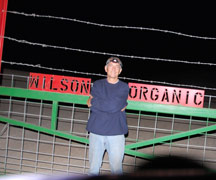The Siwa Occultation - Aug 8/9,
2009
San Lucas, California
On the late evening of Saturday night,
Aug 8, the large asteroid Siwa (m=10.7) was predicted to occult a m=11.2 star
(red magnitude = 10.7) in Capricorn from a wide path stretching from Greenfield
to about Gorman. The rank was 98 and the predicted drop was 0.5 magnitudes,
so it was a "sure thing" and worth a trip - especially since I was
just recovering from the flu and pneumonia and couldn't do much else of interest
this weekend - no racing for me for the moment. I drove to Cabrillo, packed
up the gear, went to my office and generated the hardcopy of the predictions
and maps, and headed south to my planned site at San Lucas, south of King City.
Weather was murky, with fog and a low inversion layer that trapped lots of hazy
air. I reserved the possibility of driving east from San Lucas to get into a
bit higher elevations if the sky conditions warranted. When I arrived, it looked
like I was losing close to a magnitude of extinction at around 20 degrees elevation.
The event was at 31 degrees elevation, and I hadn't checked exactly how much
elevation I could hope to gain, but I figured it was only another 1000 feet
at most, and I wasn't sure how deep the murky layer was. In the end, I settled
on my original site - the entrance to Wilson Organics farms off Oasis Road just
west of the Salinas River.
Set up was uneventful, alignment
went well; I chose Polaris and Antares to get a wide calibration. I slewed to
M55 not far from the target and it came in bang on-center in the 22mm eyepiece.
I slewed to the J2000 coords of the target star, thought I had the right asterism,
but then couldn't get the other fainter stars to work out right. I had an hour
though, and used it to patiently star hop from a bright double / double star
north of the target. The star and asteroid were clearly separted but quite close
together at this time.
The sky was hazy, and there was a
light wind from the northwest, and a 90% moon 47 degrees away. Seeing was mediocre,
but there were no clouds or hint of fog anywhere. Temperature about 60 degrees
F.
Notes: The rectangular
Canon ZR45mc LCD screen is about 13 arcmin wide with the f/3.3 and PC164cEX2
at Cass focus. You twist the focus knob 1.3 revolutions clockwise after removing
the 22mm Nagler/Diagonal combo and inserting the video camera and 1.25"
sleeve all the way, to get the stars in focus on the LCD screen.

I'm at the entrance to
the wide dirt road - Wilson Organics - is on the gate. I'm about a quarter
mile from the Salinas River just off the top of the GoogleEarth shot.
|

This first
plot didn't look good. I thought it might be that the red circle was too
tight around the target and the inner sky circle too close and picking
up some wandering star PSF. Wanted to show it for reference. The star
was not well focused, even at best moments. |

Much better with the inner
sky circle expanded to 13. Also tried changing 'drift' to 'anchor' -
gave bad wandering light curve. Make sure 'drift' is set for both target
and (yellow) comparison stars in the future.
|

The Occular 4.0 solution
from the .csv file. Limovie mistook a few 8's for 6's on the time stamp.
Manually fixing made for a 'pass' on data integrity. I zoomed in on
the occultation light curve, trimming some at the begin and end here.
|

The errors about the solution
look nicely Gaussian
|

There's a slightly suspicious
dropout at frame ~966, which is probably statistical noise but was the
most suspicious point for a secondar "moonlet".
|

Clicking "Final
Report" it gives 5 red, 6 gray, and 89 green solutions |

|
Tony George used my .csv file to
generate an Occular final report, below, with slightly wider data range and
different wing size assumption. Thanks, Tony!

The Darth Vader helmut
shadow is from my lens hood
|

My hero shot
|
Magellan GPS says: Long = 121deg 02.04' Lat=36deg 06.65'. Topo map says elevation
of telescope was 400 ft. WGS84.
Garmin GPS hooked to Kiwi says: Long=121 02m 02.538s, Lat=36 06' 38.68"
WGS84
I've also got a couple of pix of the site, I was 61.4km north of the
centerline.
Brad
Timerson's reduction of all the observations of this event; Patrick
Wiggins' timings are preliminary. My
Excel IOTA report.







